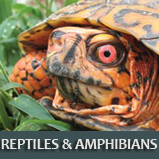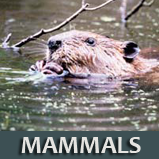Wildlife overview
See also: All wildlife entries; Alligators; Audubon Society of North Carolina; Beavers; Cardinal; Terrapins; Waterfowl.
Wildlife profiles by region: Coastal Plain; Piedmont; Mountains; Vegetation by region
Wildlife in North Carolina is abundant despite the state's large human population and increasing urbanization. Approximately 1,270 species of mammals, birds, reptiles, fish, amphibians, and mollusks can be found, of which nearly 200 species are protected by state or federal endangered species laws. North Carolina's three main regions—Mountain, Piedmont, and Coastal Plain—are themselves divided into dozens of habitats for animals. These habitats range from the spruce fir forests of high mountains, which are remnants of the last Ice Age and harbor several species of hardy animals, to the longleaf pine savanna and pocosins, which have their own distinct residents.
Along the coast, salt marshes are the most important environments for both humans and animals. Like every other wetland, marshes swarm with life. For many fish and shellfish species, the salt marsh is their nursery. Crabs, oysters, shrimp, flounder, mussels, bluefish, croakers, egrets, herons, and multitudes of other creatures live, or certainly feed, in the salt marshes of the coast. Along the "ocean hardbottom," sea turtles, clams, corals, and hundreds of fish species frequent the fertile, rocky outcrops of old river channels that were covered up as the sea level rose at the end of the last Ice Age. The diversity of the dozens of habitats in the state has provided havens for the many animal species that have populated North Carolina throughout its history.
Learn more about North Carolina's:
References:
Jim Dean and Lawrence S. Earley, eds., Wildlife in North Carolina (1987).
Doug Elliott, "Bats Aren't So Bad," Wildlife in North Carolina 54 (November 1990).
John A. Fussell III, A Birder's Guide to Coastal North Carolina (1994).
David S. Lee and James F. Parnell, Endangered, Threatened, and Rare Fauna of North Carolina (1990).
Margaret Martin, A Long Look at Nature (2001).
William M. Palmer and Alvin L. Braswell, Reptiles of North Carolina (1995).
Eloise F. Potter, James F. Parnell, and Robert P. Teulings, Birds of the Carolinas (1980).
Fred C. Rohde and others, Freshwater Fishes of the Carolinas, Virginia, Maryland, and Delaware (1994).
William D. Webster, James F. Parnell, and Walter C. Biggs Jr., Mammals of the Carolinas, Virginia, and Maryland (1985).
1 January 2006 | Bell, Larkin; Carter, Kathy; Erickson, Evan L.; Freeman, Joan E.; Hairr, John; Harris, William C.; Mills, Jerry Leath; Smith, Clyde; Snow, Jean; Templeton, Lee Plummer; Wait, Douglas A.



